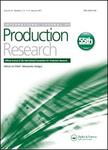版权所有:内蒙古大学图书馆 技术提供:维普资讯• 智图
内蒙古自治区呼和浩特市赛罕区大学西街235号 邮编: 010021

作者机构:Hangzhou Dianzi Univ Sch Management Hangzhou Peoples R China Hangzhou Dianzi Univ Expt Ctr Data Sci & Intelligent Decis Making Hangzhou Peoples R China Shanghai Univ SILC Business Sch Shanghai Peoples R China
出 版 物:《INTERNATIONAL JOURNAL OF PRODUCTION RESEARCH》 (Int J Prod Res)
年 卷 期:2025年第63卷第11期
页 面:4163-4179页
核心收录:
学科分类:12[管理学] 120202[管理学-企业管理(含:财务管理、市场营销、人力资源管理)] 0202[经济学-应用经济学] 02[经济学] 1202[管理学-工商管理] 1201[管理学-管理科学与工程(可授管理学、工学学位)] 0802[工学-机械工程]
基 金:National Natural Science Foundation of China [72371086, 72201082, 72171065] Zhejiang Provincial Philosophy and Social Science Planning Project [23SYS11ZD]
主 题:Product family supply chain resilience order allocation order reallocation nested genetic algorithm industry, innovation and infrastructure
摘 要:A product family consists of multiple components, often supplied by various suppliers. It is crucial to consider the supply risk of these suppliers during product family configuration to ensure that orders can be replenished by alternative suppliers in the event of component disruptions. This study establishes a new optimisation model that concurrently addresses product family configuration and supply chain resilience for the first time. The model is further linearised, making it readily solvable using commercial optimisation software packages for smaller-scale problems. A nested genetic algorithm for solving the large-scale problems is also developed. The proposed method is demonstrated through a case study involving e-book products. The numerical results indicate that the joint optimisation method outperforms other methods, and the nested genetic algorithm achieves high-quality near-optimal solutions with good stability. A sensitivity analysis based on the e-book case assesses the impact of several parameters on profit, including supplier flexibility, unit loss cost, and disruption probability. The findings underscore the importance of supplier flexibility in supplier selection and suggest that companies should carefully evaluate unit loss costs across different module instances, as well as the regional risks associated with suppliers.